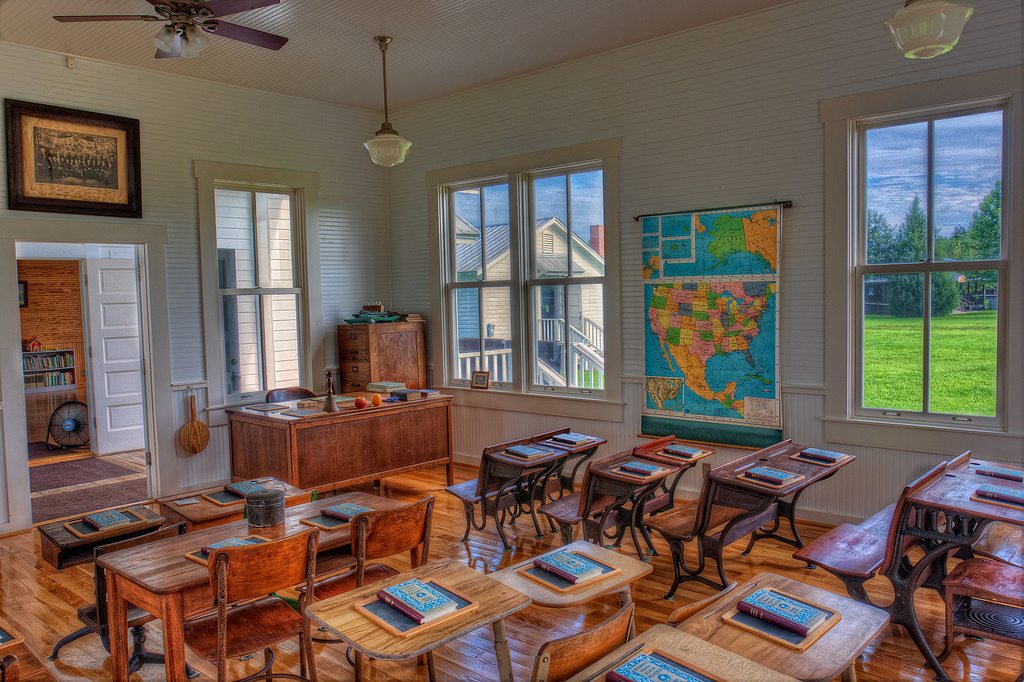My name is Nathan Olsen and I am a sixth grade teacher in Madison, Wisconsin. A good portion of my day is spent teaching ancient civilizations to eleven and twelve year olds. We start the school year with Early Hominids, and finish with the European Middle Ages. Millions of years of history condensed into nine months? I call it a buffet of history. We never go in-depth on any one topic; we go in-depth on the skills required to be a historian.

Teaching has come a long way since these types of classrooms. How are you making your class more engaging? Photo by Matthew Paulson / Flickr.
The first question I am asked by new acquaintances, usually with a look of shock, is why do you teach . . . and why do you teach that age group? My father raised me to believe that finding your passion in life is a major key to happiness. Teaching is my passion because it keeps me on my toes, takes me on a path as a lifelong learner, and allows me to spend six hours a day with 56 of the most fascinating individuals I’ve ever met. Eleven and twelve year olds are at an age when they still have a wide-eyed fascination of their world. They are starting to question authority, starting to become independent mini-versions of adults, and starting to understand sarcasm. I can honestly say that I have never had two days of work that are even remotely similar.
In the constant overemphasis of math and literacy, elementary school teachers typically have about two hours a week to squeeze in a history curriculum for their students. For a large number of middle school students, this is the first time they are scheduled with a required one-hour per day history class, taught by a certified history teacher. This is their first chance to experience consistency with a history curriculum. Unless they have been conducting research on their own time, students are encountering ancient civilizations for the first time. This perfect storm of firsts brings an engaged attitude to the classroom. The glazed-over eyes of students in language arts, reading, and math classes are replaced with enthusiasm. When an outsider walks into my classroom, I like to describe our space as controlled chaos. Students moving, arguing (we call it academic arguments), writing, typing, engaging in simulations, and collaborating with their peers–usually at a noise level that rivals our lunch room or recess. Learning should be hands on, learning should be fun, and learning should be loud. This is why I teach.
A little bit about me: I was born and raised in the redwoods of northern California, I completed my undergraduate degree in Education at the University of Wisconsin-Madison, and immediately began my teaching career at a nearby elementary school. After one year of teaching 4th and 5th graders, I transferred to a middle school in the same district. After two years of teaching, I went back to school and received my master’s degree in Curriculum and Instruction. I am now 29, beginning my sixth year of teaching, and living the dream! Ancient History Encyclopedia caught my eye during a search for information on a project for my masters in 2011. In particular, the vision of presenting history without an agenda appealed to me as an educator. Teaching students to look through the lens of different authors, read beyond the biases, judge possible motives for authoring of documents, and guiding them on a path towards becoming critical thinkers have been a few primary goals in the early stages of my teaching career.
My goal in writing blog posts for Ancient History Encyclopedia is to discuss the craft of teaching ancient history from the viewpoint of a middle school teacher. I hope that this can be a collaborative effort, and readers are encouraged to comment with topics we can discuss.
